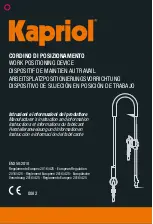
33
Of course if both the closer baffle-to-microphone distance AND absorbing floor reflections can be
achieved, then a 12ms delay would be possible before the first reflection needs to be truncated,
providing accurate bass phase information down to around 100Hz.
Why not measure very close to the speaker’s baffle?
As noted above, the closer the microphone is to the speaker driver/s baffle, the less will be the
corruption from room reflections. For example, if the microphone is at least one metre away from
the nearest reflective surface, but only a few inches away from a driver, there will be virtually no
reflection heard by the microphone compared to the direct sound - an ‘ideal’ measurement
scenario since virtually no truncation will be required at all. This is how subwoofers, full-range or
co-axial drivers can be measured for example. The down side of very close measurements is that
the speaker baffle itself contributes reflections that can entirely cancel out some frequencies in its
near field depending on its width. Measuring a passive speaker ‘triangulation’ between multiple
drivers will also confuse close measurements. Triangulation timing errors are not a problem if
measuring ‘active’ speakers – i.e. if DEQX’s linear-phase crossovers are bi-amping or tri-amping
the speaker. This is because the stand-mounted measurement mic can be lifted and lowered to
be on axis with each driver as it is being measured (it’s an option to ‘pause’ measurements
between drivers to enable moving the mic height to be on-axis with each driver, and so to be
located closer to each driver - say 30cm to 50cm).
What’s a good low frequency target for anechoic correction?
We are psycho-acoustically less aware of phase errors at lower frequencies due to their long
wavelengths, which interact with our listening room significantly. For example 200Hz has a
wavelength of 1.7 metres (5.7 ft), if practical it is desirable to correct down to about 200Hz or
below, implying a truncation target approaching about 6ms or more.
As a general rule, DEQX correction strives to be ‘anechoic’ above about 200Hz (upper bass) and
include room reflections below that using DEQX’s ‘room correction’, which uses minimum phase
parametric Equalisation. However, where separate bass drivers can be driven independently by
the DEQX unit e.g. main speakers plus subwoofer/s configuration, these can be corrected using
separate left/right DEQX ‘speaker measurements’ but measured from the listening position/s
where no attempt is made to remove room reflections from the measurements, so that room
reflections will also be processed in the time-domain, after which Para EQ can also be added if
desired.
As you can see there are several options regarding achieving the best measurements that
depend on your loudspeakers (e.g. are they too big to be moved etc) and your listening room.
DEQX can supply general advice regarding your circumstances through [email protected], or
for detailed assistance as well as software operation or full installation where we run the software
for you, we highly recommend the use of our DEQXpert installation service.
Note - the 'Sensitivity' column is not currently enabled.
Once the crossovers and the limits have been set as desired, the correction set for the speaker
(or speakers) is generated by clicking on the Finish button.
More than one correction set can be generated if desired. A correction set will contain one or
more correction filters – one for each speaker that has been corrected.
Ensuring Calibration Quality
Follow these tips to ensure that you produce the best possible calibration.
1. Correct all the speakers that will be used at the same time (e.g. Left and Right) by ensuring
they are all 'ticked' in the Calibration Wizard. This gives the best phase matching.
2. Experiment a little. Try using different crossover frequencies and see what gives the best
Содержание DEQX-Cal
Страница 1: ...Installer s Manual DEQX Cal Version 2 90...
Страница 39: ...39 Select the speaker that you wish to verify then click Next...
Страница 41: ...41 Once the measurement is completed click Next...
Страница 61: ...61 Part of the room measurements for left and right speakers prior to the addition of any parametric EQ...
Страница 62: ...62 One band of parametric EQ applied to the room measurements duplicating the line of the room measurements...
Страница 82: ...82...
Страница 98: ...98 Select the speaker that you wish to verify then click Next...
Страница 104: ...104 Smoothing can also be applied to an individual plot by entering a value in the Smooth column for the relevant plot...
Страница 106: ...106...
Страница 118: ...118 An anechoic measurement of a speaker with 75 smoothing The same anechoic measurement with 100 smoothing...
















































